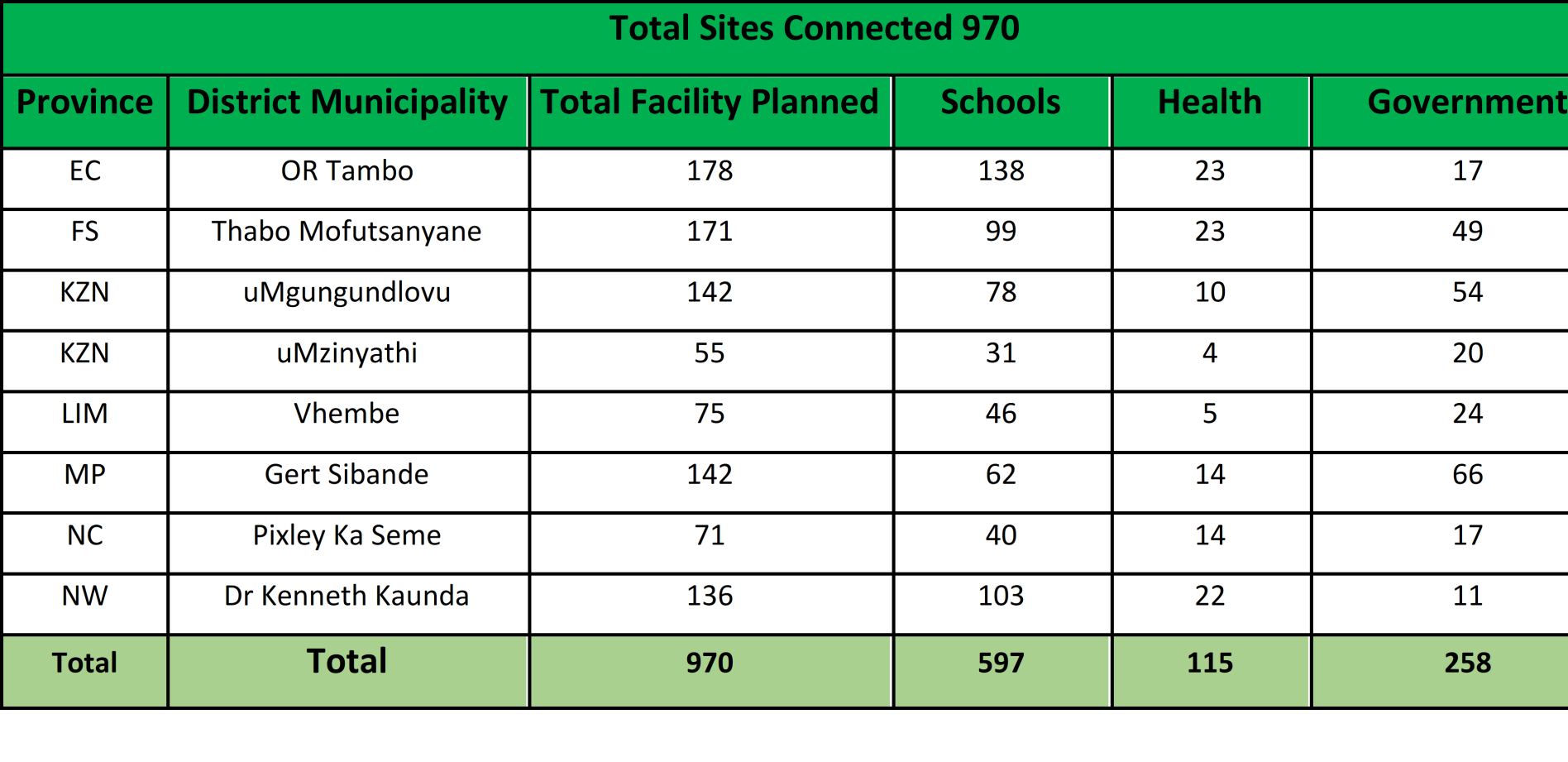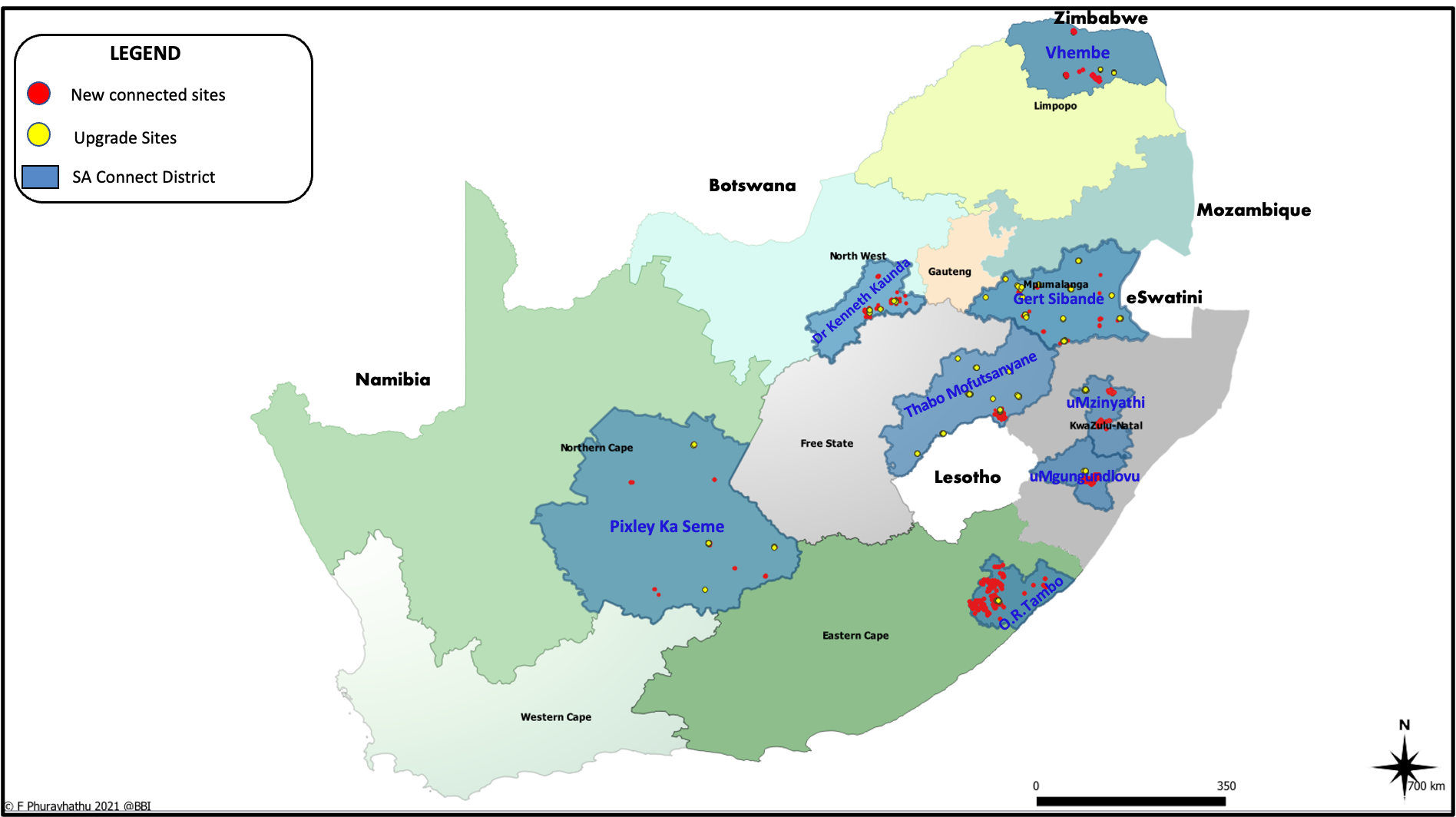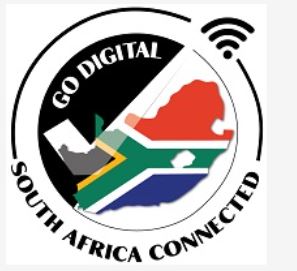SA CONNECT
OVERVIEW
SA Connect is the implementation of the national broadband policy that was approved by Cabinet in 2013. SA Connect seeks to meet the technology goals of the National Development Plan of creating an inclusive information society and position the government to play an enabling role in the provision of broadband to the number of underserved district municipalities thereby bridge broadband connectivity gaps. This would be achieved by the pooling of public sector demand and procuring of high-capacity and future-proof network capacity at more affordable rates to address public sector broadband requirements. And in the process stimulating network builds by the network operators by reducing the associated investment risk, by ensuring demand. Due to the magnitude of the project, the programme was divided into two phases, phase one and phase two.
PHASE 1
In terms of phase one, the programme initially aimed at connecting 6135 government facilities, which include all schools, health facilities, post offices, police stations and government offices, in the eight rural district municipalities, to broadband services. Phase one scope was subsequently reduced to 970 government facilities due to budget constraints.
Government has mandated the State Information Technology Agency (SITA) and Broadband Infraco (BBI) to provide the end-to-end broadband services to the 970 government facilities in the eight identified district municipalities, namely (1) Dr Kenneth Kaunda in North West, (2) Thabo Mofutsanyane in Free State, (3) OR Tambo in Eastern Cape, (4) Vhembe in Limpopo, (5) Gert Sibande in Mpumalanga, (6) Pixley ka Seme in Northern Cape, (7) uMgungundlovu and (8) uMzinyathi in KZN. The remaining 5165 facilities that were not provided with broadband service due to the limited budget allocation for the programme will be transferred to phase two of the programme.
Breakdown of Phase 1 connected government facilities:
Maps of the 8 District Municipalities:

SA CONNECT PHASE 2 HITS CRITICAL MILESTONES
While broadband is seen as a powerful tool for economic and social development and for effective and efficient government service delivery, South Africa is still challenged by issues of broadband accessibility, usability, and affordability. South Africa’s terrestrial fibre routes are in excess of 200 000 kilometres. Through Phase 2 of SA Connect programme, additional 1180 kilometres of terrestrial fibre is planned to be deployed to enable coverage of about 5.5 million households.
According to ICASA State of ICT report released in 2024:
- Fibre-to-the-home/building internet subscriptions increased from 1 365 429 in 2022 to 1 488 483 in 2023.
- National population coverage for 3G stood at 99.40% in 2023. National population coverage for 4G/LTE stood at 80%. National 5G population coverage increased from 20% in 2022 to 38.42% in 2023, marking a substantial increase in a single year.
- At the national level, there is 78.9% of universal connectivity, with 82.1% regarded as meaningful connectivity in the ITU database for 2024 report.
- In 2021, 69.4% of households nationally had access to the Internet using mobile devices, with the majority of this access accounted for by Households living in urban areas at 73.3%, and metropolitan areas accounting for 73.4%. Mobile devices are also the most used means of accessing the Internet by Households in rural areas, at 59.2%.
SA Connect is a national broadband policy and strategy approved by the Cabinet in 2013. Its aim is to galvanize the public and private sectors' capability, resources, and energy to realize a bold vision of a connected society through accessible, quality, and affordable broadband connectivity. Due to its scale and complexity, the programme was divided into phases: Phase 1, the pilot, and Phase 2.
Phase 1 was implemented in 2017 through an “anchor tenant” approach, providing broadband connectivity to schools, health facilities, and other government facilities in 8 selected districts to stimulate private sector investment in broadband infrastructure.
In 2022, the Cabinet approved the revised SA Connect Phase 2 model to roll out broadband infrastructure to enable connectivity countrywide. The key objective of the revised SA Connect model is to achieve 100% broadband access for all communities and Government facilities. The programme aims to connect South Africans within 36 months (2023/24 – 2025/26) at a minimum speed of 5 Megabits per second (Mbps) for households and 10 Mbps for Government facilities, including public schools and health facilities.
The revised SA Connect model, which is currently being implemented, comprises the following key interventions:
- Community and households’
- Connectivity of government facilities; and,
- Universal Service Obligations.

The SA Connect programme is expected to:
- Provide connectivity at a minimum speed of 5 Mbps for households and at 10 Megabit per second (Mbps) for government The speeds are expected to be upgraded in the future.
- Leverage universal service obligations to fund the connectivity of schools.
- Leverage national, provincial, and municipal budgets to fund government connectivity and the Universal Service Access Fund for subsidies.
- Leverage ICT infrastructure owned by non-ICT SOEs, provinces and
- Use last-mile providers and internet service providers, including local SMMEs, virtual network providers, to extend connectivity from government facilities to households and create public Wi-Fi hotspots which is inclusive of Broadband Access Fund.

- Align with the District Delivery Model and prioritise provinces/district municipalities based on quick wins and the highest impact achievable.
Broadband Infraco and Sentech will, in conjunction with the ICT industry, particularly Small, Medium and Micro Enterprises (SMMEs), provide broadband services to South Africans, primarily through the deployment of 32 055 Wi-Fi hotspots, enabling the connectivity of 5 573 258 households over 36 months.
The table below shows the breakdown of WiFi hotspots per province:

Sentech and BBI have deployed around 7 185 Wi-Fi hotspots nationally, providing coverage for 1 250 190 households. The breakdown of the deployment of Wi-Fi hot spots per province in relation to actual targets achieved to date:

SITA has connected Government National and Provincial Departments under SA Connect phase 2. The table below highlight is the current existing sites that are on the SITA Next Generation Network (NGN) that are being sustained.


